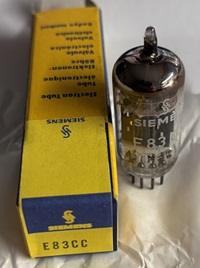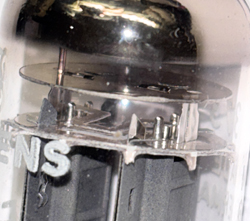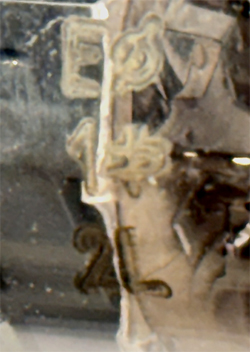NOS E83CC, Triple Mica, Siemens&Halske.
E83CC is the designation for the studio version of ECC83. Standard ECC83 has a data sheet with only "typical" numbers, and there is no standard what is acceptable or not. E83CC however, has minimum and maximum values for all important data, and also a test instruction how to determine "end of life" limits. Moreover, it is a long life, low noise version.
 Sometimes I get a call or an Email, saying do you want to buy tubes? Most of the time people are trying to sell a private tubes collection, most of them slightly used, just a few of type each. Specially when these are 100's or 1000's of tubes, price expectation is unrealistic high. Such collections are very hard to sell. .
Sometimes I get a call or an Email, saying do you want to buy tubes? Most of the time people are trying to sell a private tubes collection, most of them slightly used, just a few of type each. Specially when these are 100's or 1000's of tubes, price expectation is unrealistic high. Such collections are very hard to sell. .
It is really rare to be offered something nice for a reasonable price. In 2024, I was contacted by a circuit designer, who has worked for the German company Experience Electronics, at the time when this company was still in business. The owner, Werner Haas has since passed away, and his company was shut down. The developer is retired, and during final inventory, these excellent Siemens&Halske E83CC popped up, in a forgotten box, and then he called me. Sometimes it happens :)
What makes E83CC so much better as the standard tube, ECC83
 It is not a matter of just writing the more expensive type number on the tube, like is common practice with the Electro Harmonix company. It also requires improved hardware, and a more detailed data sheet, listig the performed tests. an E83CC is ony a real E83CC, when it complies to vintage data sheet, and all test are done, and done the same way.
It is not a matter of just writing the more expensive type number on the tube, like is common practice with the Electro Harmonix company. It also requires improved hardware, and a more detailed data sheet, listig the performed tests. an E83CC is ony a real E83CC, when it complies to vintage data sheet, and all test are done, and done the same way.
Specifications according to the German data sheet:
- Specially suited for Audio Applications (Called: "NF" in German)
- Low microphonics. Specified in two ways: 1) The tube can be used without special precautions, for input signals as low as 0.5mV. 2) Biased at 250V / -2V, vibrate the tube with 2G at 25Hz. Any signal at the output caused by this will not exceed 10mV in the range of 20Hz....5kHz.
- Long Life, minimum 10.000 hours
- Tighter tolerance (Many details in the data sheet)
- Double isolated Cathode. (Only such tubes can be used in stand by mode)
- Low defect rate. Specified 0.1% per 1000 hours.
- Maximum Grid Current 0.2uA
- Cut off voltage is specified (-4V)
- Minimum and maximum values for plate current and transconductance.
- End of Lifetime is specified and how to test this
These very rare tubes are often referred to as TRIPLE MICA normally, but I noticed they have FOUR mica plates actually, of which the middle two are attached to each other.
 The tubes have the old Siemens & Halske brand, as in the middle of this picture.
The tubes have the old Siemens & Halske brand, as in the middle of this picture.
At its time, E83CC was the Siemens answer to the legendary Telefunken ECC803S. We see the E83CC also from Valvo, but the small printing has the S&H special sign. (Letter H on it's side). Telefunken used a so called frame grid, to reduce the microphonics. Siemens went another way. To explain this, let's call the bottom mica the first mica. The second mica is then on top of the tube, and normally a tube would be finished by that. First and second mica are specially treated, with salt and heat, after which they get the typical powdery gray appearance. Then, on top of the second plate is the third mica attached. This is a thin, transparent mica, with special carvings, forming a spring. This spring rests on the cathode sleeve, preventing microphonics. In 3mm distance above that, the fourth mica is attached. It's function is to keep any residue of the getter flash away from the tube system. Such traces if they are formed in an unlucky way, can cause noise. With the extra mica plate, any such traces would attach to it, and will not do any harm. Though count ineed FOUR micas, this tube is refered to as the triple mica. A property which can not be faked, and not many were made.
 Here you can see the mica damper plate. On the picture you see this "Z" like shape, the left end rests on the cathode sleeve. The right end is not visible on this picture, it rests on the cathode of the other system. If you click on the picture, so enlarge it, you can see the plate in the middle, is two plates attached to each other. Such a beautiful tube. I think you can not develop this technology any further.
Here you can see the mica damper plate. On the picture you see this "Z" like shape, the left end rests on the cathode sleeve. The right end is not visible on this picture, it rests on the cathode of the other system. If you click on the picture, so enlarge it, you can see the plate in the middle, is two plates attached to each other. Such a beautiful tube. I think you can not develop this technology any further.
 This is the etched printing.
This is the etched printing.
In the middle is the ≠ symbol, which stands for Siemens & Halske, Munich, Germany.
What I like so much about etched printing, I have not seen this faked yet.
More info about small printing
The tubes are all from the same batch number, which is 373.
Matching.
The tubes are supplied with an AT1000 computer test report. It is unbelievable quality. I verify it of course, but I can take just two random tubes, and chances they are a perfect pair almost 100%. Even Telefunken ECC83 does not even come close to this. So far, I have only seen this with Tesla E83CC, of which I opened the sealed master carton myself. For the rest, I have never seen this before. With low gain tubes yes, but not with a high gain tube like E83CC (or ECC83)